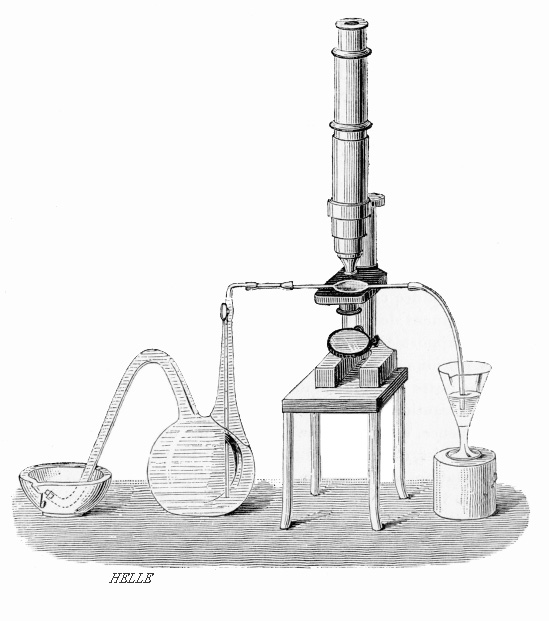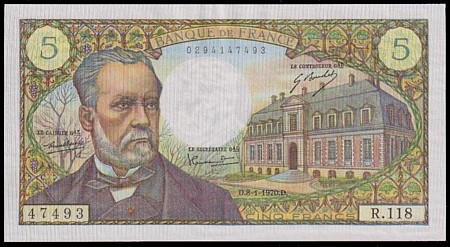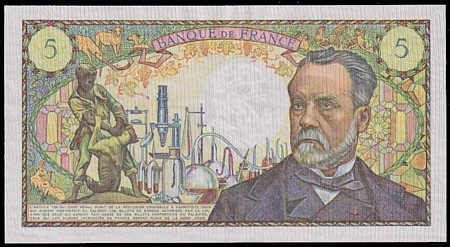France
5 Francs 1970 featuring Louis Pasteur

Born on 27 December 1822 in the eastern French city of Dole, Louis Pasteur was the third child of Jean-Joseph Pasteur & Jeanne-Etiennette Roqui. His father,Jean-Joseph, was an ex-army sergeant who had served in the Napoleonic wars and had opened a tannery after his discharge. His family relocated a couple of times and eventually settled in the nearby town of Arbois in 1827.
An average student at school, Louis Pasteur had shown some young promise as an artist, but when he left home to attend his advanced studies, he began to show more promise in more academic areas, to the point of earning several degrees in science and mathematics by 1845.
Long before his death, Louis Pasteur would become one of the most well-known scientists in the world, and with good reason. His accomplishments have bettered the lives of people the world over, saving many millions of lives. Known as the “Father of Microbiology”, he discovered a method of preserving foods which became known as Pasteurization, developed Germ Theory proving that germs can cause disease which led directly to his improved method of making vaccines and helping to cure rabies and anthrax – two diseases most of us know, thanks to Louis Pasteur, only from text books.
By 1848 he was a professor of physics in Strasbourg and it was there where he met Marie Laurent who would become his wife the following year. It was at that time when he was working on crystalized structures of fermented materials. He discovered that there were, in fact, mirrored crystals with left and right faces which, when combined, would cancel out polarized light. This discovery revealed that studying the structure and the shapes of chemical compositions was vitally necessary to determine how chemicals behave.
Advancing to become the professor of Chemistry, Pasteur quickly became the Dean of Faculty at the University of Lille in 1854. While in Lille, Pasteur was working with a local beer brewer to overcome fermentation issues that had been plaguing his production. At the time there was a disagreement with scientists as to how fermentation actually occurred, the majority thinking it was merely a chemical process, while others thought it was due to a living organic process due to microbes in yeast. Pasteur undertook studies other types of fermentation including milk, vinegar and wine, and through his acute observation he determined that fermentation was a result of specific types of bacteria and yeast. This revelation would lead to further experimenting with heating liquids to specific temperatures to kill most of the harmful bacteria. His work was eventually patented as Pasteurization in 1865, resulting in a worldwide change in the manufacture and preservation of liquids, increasing production, quality, shelf-life and reducing illness and waste.
Pasteur didn’t stay too long in Lille and in 1857 he accepted the position of Director of Scientific Studies at the École Normale Supérieure in Paris. While Pasteur had more than overcome his ‘average ability’ in schoolwork, his tenure at the École Normale Supérieure required more management ability which he seemed to still be at an ‘average ability’.

It was during his early tenure at the ENS when he ran into a bit of trouble. His management approach was at first that of using an ‘Iron Fist’ approach, and that led to some students revolting. But it wasn’t simply his lack of expertise in management that caused the issues. Pasteur was actually trying to strengthen the schools reputation in improving their scientific training. But when he declared that any student caught smoking would be expelled, 73 of the school’s 80 students resigned. He was, however, proven right in the end; his improvements, though some were undoubtedly unpopular, did achieve the result of improving the curriculum and produced far better scientists.
In 1877 Pasteur had been busy studying the effects of Cholera bacteria in chickens for two years when he noticed that the strain of bacteria cultures were becoming less and less effective over time. In 1879 his assistant, Charles Chamberland, forgot to inject a strain into chickens before leaving on holiday. Returning a month later, the assistant then injected the chickens with the old bacteria, but instead of dying, the chickens sickened and then recovered. Presenting his ‘mistake’ to Pasteur, the assistant was about to discard the entire culture and start over. Pasteur instead injected the same chickens with a newer culture. The chickens showed no sign of the disease, and Pasteur found that the older cultures that were weakened by oxidation resulted in an effective inoculation. This discovery caused Pasteur to focus further studies on immunization.
That same process did not prove to be true for all diseases, though. Experiments with Anthrax proved to be non-effective when following similar methods, so instead he produced a culture that was produced at a higher temperature of 42 degrees Celsius (107 degrees Fahrenheit) in which the Anthrax failed to produce any spores. This worked, and all his experiments using this method of vaccine proved successful. To help prove his point to the broader public and farming community, a public experiment was conducted in 1881 with sheep, goats and cattle. All the inoculated animals survived while those unfortunate animals which did not receive Pasteur’s inoculation died.
His work on rabies is, next to pasteurization, his most famous accomplishment. Experiments led Pasteur to use a surrogate and he used several rabbits, and when the disease was sufficiently attenuated by drying the vaccine in air, he experimented with injections of infected dogs. He discovered that successive injections of less and less attenuated emulsions of rabies, the dogs would recover. His experiments were done on 50 dogs before any human received the treatment. On 6 July 1885, a case of a 9 year old boy who had been mauled by a rabid dog was presented to Pasteur. The boy was sure to die from rabies but Pasteur could not inject a human without fear of prosecution if something would go wrong, even if the boy would have died otherwise. After careful consideration, Pasteur agreed to take the chance. Over a two-week period, Pasteur injected the young boy with 12 vials of his attenuated serum from infected rabbits, each one less and less attenuated. The boy survived.

Illustration of a man fighting a rabid dog from 5 Franc banknote. This is from the bronze monument of a shepherd-boy, Jean-Baptiste Jupille, struggling against a rabid dog at the garden of the Pasteur Institute in Paris. The statue by Emile-Louis Truffot.
Jupille was the second person ever inoculated by Louis Pasteur against rabies in July 1885, after 9 year old Alsatian boy named Joseph Meister. Both Jupille and Meister would later work at the Pasteur Institute
Additional vaccines were administered as cases were brought to him, and the remarkable success of his vaccine would lead to the reduction of fatal Rabies cases in human beings if treatment was administered promptly.
Louis Pasteur would later become the director of Physiological Chemistry at the École Normale Supérieure where he would remain until 1887 when he established the Pasteur Institute, which conducted research and conducted practical applications by bringing together scientists with varying specialties to work together, bringing a new age of Preventative Medicine.
His work on fermentation continued with work on the Spontaneous Generation Theory. At the time many thought that exposure to air would create the spontaneous generation of organisms in liquid. Many different experiment conducted in open air resulted in this occurring. Pasteur, however, took a different approach and took boiling liquid and enclosed it in a flask with hot air. This resulted in no organisms growing. Pasteur further experimented with allowing dust particles to enter the flasks, organisms would grow. Pasteur also conducted an experiment using Swan Necked Flasks which, while open to the air, required that any dust particles would have to travel along the long, thin tube. His results proved that Spontaneous Generation was not a valid theory, and that the living organisms that would grow in liquid were a result of being transferred primarily through dust particles in the air.

Despite his humble beginnings and merely average aptitude in schoolwork, Louis Pasteur was wildly successful throughout his life. His success undoubtedly is due to many aspects of his life including hard work, stringent adherence to problem solving through the scientific method, and his ability to work with others. But in a quote from Pasteur we can see the insight which perhaps kept his keen mind active and wondering throughout his career:
“Posterity will one day laugh at the foolishness of modern materialistic philosophers. The more I study nature, the more I stand amazed at the work of the Creator. I pray while I am engaged at my work in the laboratory.”
Throughout his life, Louis Pasteur was awarded many honors: monies, medals, instituted in professional societies and streets, buildings, schools, hospitals and more have been assigned his name as an honorary tribute to his accomplishments and benefiting humanity. The Pasteur Institute continues to be an active leading research center, continuing work on advancing medicines, public health and science.

Below we have a French 5 Francs banknote issued in 1970 showcasing the great scientist in front of the Pasteur Institute, and at his laboratory, amidst depiction of a man fighting a rabid dog. This honored tribute just another of the many that has been and will continue to be made to a great man whose accomplishments have had such positive effects to human-kind.


French 5 Franc banknote issued in 1970 featuring Louis Pasteur, the Pasteur Institute, lab equipment and boy struggling with a rabid dog.